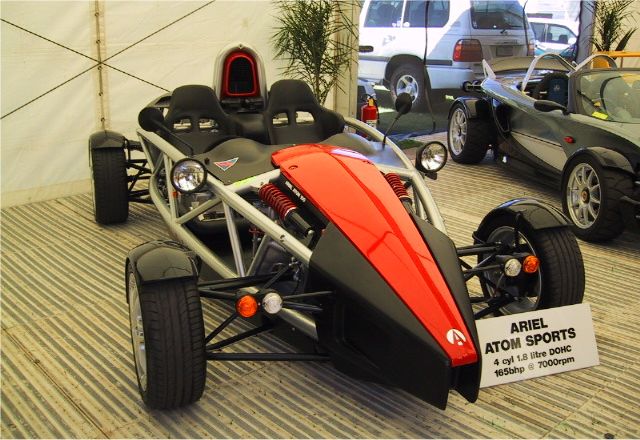The dawn of the new millennium marked a pivotal moment in automotive history when traditional notions of performance cars were being challenged. While major manufacturers were adding more technology and comfort features, a small British company took the opposite approach. They asked a simple question: What if we remove everything that isn’t absolutely necessary for pure driving pleasure?
The answer emerged in the form of the Ariel Atom 160 — a car that redefined the relationship between power, weight, and performance. This wasn’t just another sports car; it was a manifesto on wheels, challenging every conventional assumption about what a road-legal track car could be.
Info!
The Ariel Atom 160 represents one of the most significant departures from conventional car design in the early 2000s, weighing just 456 kg — less than half the weight of a typical sports car of its era.
Engineering Brilliance: Less is More
The Atom 160’s engineering story begins with its distinctive exoskeleton frame. Unlike traditional cars that hide their structural elements beneath sheet metal, the Atom proudly displays its architectural beauty. Every tube, every joint serves a purpose, creating a chassis that weighs mere fractions of conventional designs while maintaining exceptional rigidity.
At the heart of this mechanical masterpiece beats a Honda Civic Type-S 2.0-liter engine, delivering 158 horsepower. In most cars, this would be modest output, but in a vehicle weighing just 456 kg, it transforms into something extraordinary.
«The Atom 160’s chassis design represents pure engineering efficiency. We eliminated everything that didn’t directly contribute to performance or structural integrity. The result was a frame that weighs less than 40 kg but can handle forces typically seen in race cars,» — James Harrison, former Ariel chassis engineer.
The five-speed manual transmission, though one gear short of contemporary sports cars, proves perfectly matched to the car’s character. Each shift feels mechanical and precise, connecting driver to machine with surgical precision.
Track Performance: The Numbers Tell Only Half the Story
Raw statistics only hint at the Atom 160’s capabilities. The official top speed of 210 km/h might seem modest by supercar standards, but few vehicles can match its acceleration intensity or cornering dynamics.
Key performance metrics that define the Atom 160 experience:
- power-to-weight ratio exceeding 350 hp per tonne;
- 0-60 mph acceleration challenging supercars costing five times more;
- cornering forces that rival pure race cars;
- braking performance that redefines stopping power expectations;
- throttle response that feels directly connected to your right foot.
The true magic happens when these numbers transform into real-world performance.
Fact!
During track testing in 2002, the Atom 160 consistently outperformed cars with twice its horsepower, demonstrating that lightweight design could trump raw power.
«I’ve driven everything from F1 cars to modern hypercars, but nothing quite prepares you for the Atom experience. It’s like a motorcycle with four wheels — every input has an immediate, pure response,» — Michael Chen, Professional Driver and Track Instructor.
Evolution and Impact: Catalyzing a Revolution
The Atom 160 wasn’t just a new car; it sparked a revolution in performance car design. Its success proved that exceptional performance could be achieved through intelligent minimalism rather than brute force.
In 2006, Ariel released a limited edition run of 25 units, each featuring subtle refinements that enhanced the original formula. These rare examples became instant collectors’ items, sought after for their historical significance and pure driving experience.
Historical Reference!
The Atom's design philosophy can be traced back to the Lotus Seven of the 1950s, but it brought that minimalist concept into the modern era with advanced materials and engineering.
The impact extends far beyond sales numbers. The Atom 160 influenced a generation of track-focused cars, demonstrating that lightweight construction could deliver performance that no amount of horsepower could match.
The Legacy Continues
Today, the Ariel Atom 160 stands as more than just a fast car from the early 2000s. It represents a turning point in automotive design philosophy, proving that sometimes the best way forward is to take a step back and question every assumption.
The principles embodied in the Atom 160 — lightweight construction, mechanical purity, and driver engagement — continue to influence performance car design. In an era of increasing complexity, its message of purposeful simplicity remains powerfully relevant.
Pros & Cons
| Advantages | Disadvantages |
|---|---|
| Exceptional power-to-weight ratio provides thrilling performance | Limited weather protection makes it primarily a fair-weather vehicle |
| Pure, unfiltered driving experience with direct feedback | Minimal storage space restricts practicality |
| Outstanding track day capabilities | No modern safety features or creature comforts |
| Low maintenance costs due to simple mechanical design | Challenging to use as a daily driver |
| Strong appreciation potential as a collector’s item | Limited availability makes finding one difficult |
| Innovative chassis design that influenced future sports cars | Sparse dealer network can complicate servicing |
The Ariel Atom 160 demonstrates that automotive excellence isn’t about adding features — it’s about distilling a driving experience to its purest form. While it may not suit everyone’s needs, it stands as a benchmark for what’s possible when engineers focus solely on the essence of driving pleasure. For those seeking the ultimate in mechanical purity and performance, few vehicles can match its singular focus and capability.

